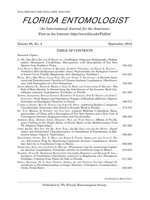The genus Culicoides includes 1,322 extant species distributed worldwide, with at least 266 species recorded from the Neotropical Region (Borkent 2012; Borkent & Spinelli 2007). In Argentina, 51 species have been recorded 21 of which were from the northeastern region (Spinelli et al. 2005) and 10 species for the northwestern region of this country (Spinelli & Wirth 1993; Veggiani Aybar et al. 2010).
The public health importance of Culicoides species includes painful discomfort and lesions caused by their bites, but also their role as vectors of diseases. Some species transmit filarial nematodes, whereas others vector several economically important viral diseases such as Oropouche, bluetongue, equine encephalitis, epizootic hemorrhagic disease, African horse sickness, Akabane and bovine ephemeral fever (Mellor et al. 2000; Ronderos et al. 2003).
We provide new records of several species Culicoides from the northwestern and northeastern regions of Argentina, in Salta, Tucumán and Misiones provinces.
Specimens were collected during the early stages of 2 research projects on bioecological aspects of Anopheles from Aguas Blancas, El Oculto and San Ramón de la Nueva Orán (Salta), Yánima (Tucumán), Pampa del Indio (Chaco) and Puerto Iguazú (Misiones). All specimens were collected with CDC light traps baited with carbon dioxide and operated from early dusk until the following morning (16:00 to 08:00 h).
Specimens were preserved in 70% ethanol, subsequently dissected and slide-mounted in Canada balsam using the techniques described by Wirth & Marston (1968), and identified by comparing them with slide-mounted specimens, photographs of female wings in the Neotropical Wing Atlas (Wirth et al. 1988) as well as descriptions and illustrations in other publications (i. e., Wirth & Blanton 1959; Spinelli et al. 2005).
Voucher specimens were deposited in the entomological collections at Instituto-Fundación Miguel Lillo (IMLA) and Instituto de Medicina Regional (Universidad Nacional del Nordeste) and Museo de La Plata (MLPA).
The following species are reported for the first time for Salta, Tucumán and Misiones provinces:
Culicoides (Culicoides) insignis Lutz: SALTA: Aguas Blancas (S 22° 43′ W 64° 22′), III-2003, X-2004, 3 females; San Ramón de la Nueva Orán (S 23° 08′ W 64° 20′), III-2004, VIII-2004, IX-2004, 15 females, 4 males, Yungas Ecoregion.
Culicoides (C.)guttatus Coquillett: SALTA: San Ramón de la Nueva Orán (S 23° 08′ W 64° 20′), X-2004, 5 females, 1 male. TUCUMÁN: Yánima (S 27° 39′ W 65° 40′), XI-2010, 10 females, Yungas Ecoregion.
Culicoides (C.) venezuelensis Ortiz & Mirsa: SALTA: Aguas Blancas (S 22° 43′ W 64° 22′), X-2004, 1 female; El Oculto (S 23° 06′ W 64° 30′), XII-2003, 1 female; San Ramón de la Nueva Orán (S 23° 08′ W 64° 20′), I-2003, VIII-2003, 3 females, 1 male; Yungas Ecoregion.
Culicoides (C.) austroparaensis Spinelli: MISIONES: Puerto Iguazú (S 25° 40′ W 54° 33′), II-2010, 1 female, Paranaense Rainforest Ecoregion.
Culicoides (C.) biestroi Spinelli and Ronderos: MISIONES: Puerto Iguazú (S 25° 37′ W 54° 35′), XII-2009, I-2010, 5 females; Paranaense Rainforest Ecoregion.
Culicoides (C.) fernandoi Tavares & Souza: MISIONES: Puerto Iguazú (S 25° 40′W 54° 33′), II-2010, 2 females, Paranaense Rainforest Ecoregion.
Culicoides (C.) foxi Ortiz: MISIONES: Puerto Iguazú (S 25° 40′ W 54° 33′), XII-2009, II-2010, 17 females, 3 males, Paranaense Rainforest Ecoregion.
The following species are recorded for the first time from other localities in Chaco and Misiones provinces, thus extending their geographical distribution.
Culicoides (C.) lahillei Iches: CHACO: Pampa del Indio (S 26° 08′ W 59 58′), X-2009, I-2010, III-2010, 5 females, Chaco Ecoregion.
58′), X-2009, I-2010, III-2010, 5 females, Chaco Ecoregion.
Culicoides (C.) brasilianum Forattini: MISIONES: Puerto Iguazú (S 25° 40′ W 54° 33′), II-2010, 1 female, Paranaense Rainforest Ecoregion.
Culicoides (C.)dureti Ronderos & Spinelli: MISIONES: Puerto Iguazú (S 25° 40′S W 54° 33′), II-2010, 1 female, Paranaense Rainforest Ecoregion.
Culicoides (Hoffmania) pseudoheliconiae Felippe-Bauer: MISIONES: Puerto Iguazú (S 25° 40′ W 54° 33′), II-2010, 2 females, Paranaense Rainforest Ecoregion.
Of the recorded species, C. insignis, C. lahillei and C. venezuelensis are the only species recognized as important vectors of human and veterinary diseases. Reports of C. insignis as a vector of the bluetongue in northeastern Argentina have been cited in the literature (Gorch et al. 2002; Ronderos et al. 2003). Perruolo (2009) reported that C. venezuelensis was also attracted to cattle; and, therefore, it may be considered a potential vector of diseases transmitted to these ruminants. Culicoides insignis and C. venezuelensis were previously recorded in the Salto Grande area between Argentina and Uruguay (Spinelli & Ronderos 1991), in the Yacyretá area between Argentina and Paraguay (Ronderos et al. 2003), and recently in Tucumán province in northwestern Argentina (Veggiani Aybar et al. 2010). Finally, C. lahillei is considered the primary vector of filariasis caused by Mansonella ozzardi (Shelley & Coscaron 2001). This disease is endemic to the Yungas or Subtropical Mountainous Rainforest (Biglieri & Araoz 1915; Mühlens et al. 1925; Romaña & Wygodzinsky 1950; Taranto & Castelli 1988; Shelley & Coscaron 2001).
SUMMARY
Culicoides insignis and C. venezuelensis are documented for the first time from Salta province, C. guttatus from Salta and Tucumán provinces, and C. austroparaensis, C. biestroi, C. fernandoi, and C. foxi from Misiones province. The geographical distributions of C. lahillei, C. brasilianum, C. dureti and C. pseudoheliconiae are extended to Chaco and Misiones provinces.
ACKNOWLEDGMENTS
We thank the Chief and Technicians of Coordinación Nacional de Control de Vectores, Ministerio de Salud de la Nación, for their invaluable collaboration during field work.





